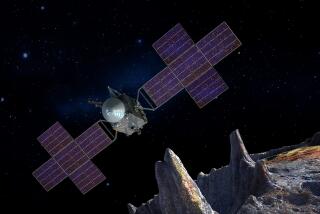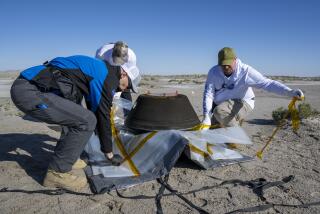Stolen from another sun: This backward-traveling asteroid could be an interstellar space fossil
- Share via
Scientists have discovered an immigrant in our midst: an asteroid near Jupiter’s orbit that arrived from outside the solar system some 4.5 billion years ago.
The orbit of 2015 BZ509, described in a letter in the Monthly Notices of the Royal Astronomical Society, could offer a way for scientists to sample the contents of distant star systems.
“If it’s a good result, it’s a little bit surprising — but promising,” said David Jewitt, a planetary astronomer at UCLA who was not involved in the research, who added that there were some questions about the model the researchers used. “It means we can do measurements in the solar system and find material that formed, probably, around some other star.”
The sun-circling orbit of asteroid (514107) 2015 BZ509, nicknamed BeeZed, is tied to the orbit of Jupiter — no surprise, given the planet’s massive gravitational pull. But what sets it apart from the rest of the space rocks under Jupiter’s influence is this: BeeZed is moving in the opposite direction from the rest of the solar system.
BeeZed was discovered in 2014 by the Pan-STARRS 1 survey in Hawaii. If its distant origins are confirmed, it would not be the only interstellar visitor to our solar neighborhood: The asteroid ‘Oumuamua was spotted in late 2017 by Pan-STARRS 1 as it sped past Mars’ orbit and toward Jupiter’s. But ‘Oumuamua is on a one-way trip out of our solar system, whereas BeeZed seems to have settled down.
If the researchers better understood the asteroid’s orbit, they might be able to determine whether BeeZed was native to our solar system or not. But that’s massively complicated, given the chaotic environment around the gas giant planet.
To pin down an answer, Fathi Namouni of the Côte d’Azur Observatory in France and Maria Helena Moreira Morais of São Paulo State University in Brazil undertook a massive simulation effort, trying out a million variations on the asteroid’s orbit. (Typical simulations use a thousand or so simulations at most, the researchers said.)
The researchers found that the orbit had been stable for 4.5 billion years, close to the very dawn of the solar system’s birth. That length of time took the researchers by surprise.
“I did not imagine the orbit to be so stable,” Morais said in an email.
Its presence so early in the solar system’s history would mean that the asteroid had to have come from another star, she added.
“In the primordial solar system all objects moved around the sun in the same direction,” Morais said. “So, at that time, we could not have had retrograde orbits which originated in our system. The conclusion is that it would have to come from another star system — captured orbits may have any orientation with respect to the plane of the solar system.”
An interstellar object today would have to traverse vast amounts of space to enter our solar system. The sun’s influence is thought to stretch to roughly two light-years, or around 11.76 trillion miles.
But 4.5 billion years ago, the sun was likely still in its stellar cradle, relatively close to other baby stars with which it was born.
“The distances between stars were much smaller than they are now,” she said.
Back then, the sun could more easily have borrowed rocky material from its neighbors, which means that BeeZed could be just the tip of the proverbial asteroid-berg.
“There should be more extrasolar asteroids bound to the Solar system on nearly polar orbits,” the study authors wrote.
But Jewitt pointed out that it’s difficult for such models to remain accurate as they reach further back in time. The model also doesn’t take into account non-gravitational forces, such as the push an icy body may get when the sun warms one side, causing its frozen reserves to sublimate.
It also doesn’t take into account the idea that BeeZed may have been made of multiple bodies, not just one, which involves a different model, he said. On top of that, it’s quite possible the planets might have been in different orbits, many eons ago — which would influence their dynamical calculations.
“It depends on things that we don’t know and I think are unknowable at this time,” Jewitt said. “But what would make a difference would be if we started to find a big population of these bodies. Because then that would probably provide some constraints that we don’t now have.”
Morais said the scientists already were on the hunt for more bodies. They plan to use their method on other strange objects in the solar system to find out where they came from.
Follow @aminawrite on Twitter for more science news and “like” Los Angeles Times Science & Health on Facebook.
MORE IN SCIENCE
Yes, President Trump, there is a difference between HIV and HPV. Here’s a handy tipsheet
A little extra global warming will mean a lot more habitat loss for plants and animals, study says
In a distant galaxy, scientists find oldest oxygen in universe and stars from edge of cosmic dawn







